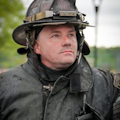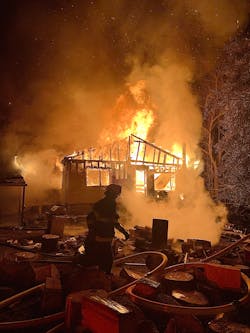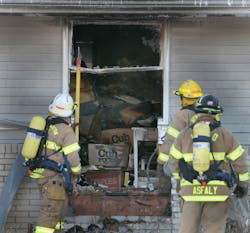Tactical Considerations for Hoarding Fires
Fighting fires that are inside of buildings that are filled with excessive amounts of stacked belongings is becoming the norm for many fire departments. As such, whether it’s stacks of materials that are inside of a cluttered garage or an entire house, firefighters must adjust when faced with the increased amount of content that’s caused by compulsive hoarding.
Three of the biggest adjustments that firefighters must consider in comparison with traditional tactics are: potential for collapse, firefighter orientation and inability to hit the seat of the fire with hose streams. Understanding the need for adjustment ties in with identifying cues and clues of cluttered environments on arrival. Some of these might be observed from the exterior, but some might not be found until you make entry into the structure.
Potential for collapse
The amount and arrangement of stored belongings (newspapers, automobile parts, etc.) can lead to overloaded structures before the first drop of water is applied. Considerations for the potential for collapse start with the type of construction of the building (for example, Type 5 wood-frame construction, balloon-frame construction, multiple stories, a crawl space, age of the building, etc.).
The next consideration is how high are the stacks of the belongings (i.e., knee-high or head-high). Ascertaining this will be very difficult in heavy smoke conditions without the use of a high-resolution thermal imaging camera (TIC).
TIC use is mandatory in cluttered environments not only in regard to identifying the height of stacks but also in regard to the stacks’ composition and the paths that they create.
Use the TIC low to keep it in the high-resolution settings to identify the stack height and what is being stored.
The height of stacks usually doesn’t become a major concern until the stacks tower over the head of a crawling firefighter. Head-high stacks become a concern because of their collapse potential, covering up exit paths and trapping firefighters.
Next, you must address the type of contents, the layout of the floor and burn amounts on the structural components.
If the TIC has the correct clarity, you can identify the contents.
A concentration of stacks in one area can create a weakened floor, which is a critical concern.
Without a doubt, the most important evaluation is the amount of burned structural components. Start by assessing whether the drywall or sheeting still is in place. Scanning with the TIC or flowing water are good options for this assessment. If the sheeting is missing and the fire has been allowed to damage structural components, collapse could be imminent based on the amount of contents.Firefighter orientation
When entering a cluttered environment, firefighters must use a triple-safe approach to ensure that they don’t get disoriented.
First and foremost, firefighters must use a TIC to scan for pathways and entry points. Look for the “goat paths” and the routes of entry that the occupant uses to access the building. If there is no path, the chances are high that you are encountering a storage area that isn’t used by the occupant, and you must find another way in. Also, use the TIC to identify objects that don’t move. Ceiling fans, bookshelves, and tops of windows and doors are great for secondary orientation inside of cluttered environments. Given that a TIC can fail while in use, having other means of orientation is very important.
The second means of orientation is a high heat rate search rope or a hoseline. Both help to reduce the chances of burn-through if laid on hot contents. Using each requires practice inside of cluttered environments because of the likelihood of content dropping on top of each.
Having one firefighter on the crew responsible for orientation at all times completes the three ways of orientation inside of cluttered environments.
Seat of the fire
The greater the amount of content inside of a hoarder home, the less chance of a direct water application to the seat of the fire. As a result, firefighters must recognize the potential need to apply an indirect or rain-down method of water application. Aiming the stream at the ceiling is a great way to distribute water over the top of the contents and get initial knockdown of the fire. Although this won’t completely extinguish the fire, it will allow time to gain access to the seat of the fire.
Firefighters who are unable to access the primary fire room might need to breach their way through an interior or exterior wall for initial indirect application of water. Use a less cluttered/uncluttered area to breach into the fire room, keeping in mind that as you breach you must do so high enough to get over top of the contents.
A matter of time
It isn’t a matter of whether you will face a cluttered fire environment. It’s a matter of when. Understanding the need to adjust your thinking—and even adding additional personnel—in a hoarder home environment increases the chances of a successful firefight. Don’t fall into the trap of believing that these are bread-and-butter fires. They are far from that.
About the Author

Ryan Pennington
RYAN PENNINGTON is a 22-year veteran of fire/EMS. He currently serves as a captain/paramedic with the Charleston, WV, Fire Department, where he has served for the past 12 years. Pennington has lectured and trained thousands of firefighters across the United States and internationally at conferences, including Firehouse Expo and Firehouse World, and has been published in many fire service publications.

